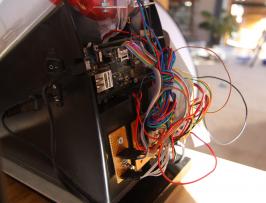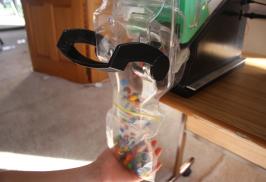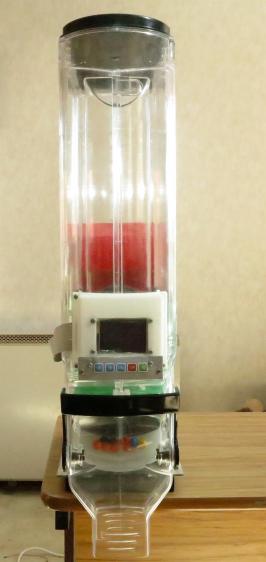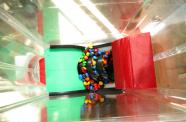Automated dispenser engages student in scholarship
iDispense!
Nathan had noticed as a regular customer that the buying experience in bulk bin stores was not always great:
- working out how much scroggin or pick-n-mix to dispense and what it would cost was frustrating and often resulted in buying more than he wanted
- some of the fully enclosed dispensers that used a lever mechanism had no facility to return unwanted product
- in some bulk bins hygiene was an issue – customers could put their ungloved hands in to scoop out the product.
Nathan’s solution was iDispense, an automated dispenser for bulk bins.
In year 11, Nathan was awarded scholarship for his iDispense submission, and in years 12–13 he went on to refine his prototype.
A clip from Nathan's video presenting iDispense
Exploring ideas for a scholarship project
Key factors in Nathan James' successful choice of a scholarship project were:
- personal interest
- availability of expertise outside of school
- originality.
At the end of year 10, Nathan knew he was going into the technology scholarship class. Over the summer break he started to think about and discuss projects that he might attempt.
Nathan's choosing strategy included an initial brainstorm, which narrowed his options down to two possibilities:
-
an app to enable farmers to monitor specific parts of their farm irrigation system
(he discovered that this was already available) - a way of improving the current bulk-bin dispensing systems in supermarkets.
At Burnside High School students present their ideas to their scholarship class and teacher. They must argue convincingly that this is an original idea and worthy of a scholarship submission. Students also discuss their project ideas with interested parties and gauge their responses.
Synthesis, abstraction, originality and/or elegance, and complex situations are just some of the requirements of the performance criteria for technology scholarship.
Access to outside expertise and equipment

It is worth thinking about the type of expertise that a student may need to develop a solution. Some of this expertise may need to be sourced outside of school.
The expertise that Nathan had access to included:
- John Creighton – Technology teacher/mentor
- Bridget McKendry – Maker Crate 3D Printing enthusiast (advised on printing the worm for the dispensing system and on the stepper motor)
- Bruce Sparks – Learning Facilitator, CPIT Engineering department Christchurch Polytechnic (advised on the design and mechanics of the worm)
- Joe Colquitt – Electronics Enthusiast (gave Nathan two electrical circuit boards and a two-stepper motor)
- Andrew Hornblow – Electronics enthusiast from Brightsparks (advised on electronics technology)
- Ross James – Father (gave advice and components as a programming and electronics enthusiast)
All three curriculum strands

The scholarship performance standard requires students to critically reflect on technological experiences that cover all three of the curriculum strands – technological practice, the nature of technology, and technological knowledge.
This project lent itself well to exploring understandings within the nature of technology strand. Shopping experiences and food wastage are popular topics that have strong socio-cultural links.
Nathan made links to the level 8 indicators for the characteristics of technology component, for example:
-
discuss why technology can challenge people’s views of what it is to be "human"
Nathan notes that grocery shopping has almost gone full circle in the last 100 years. In 1915 consumers limited shopping time and quantity because it was all done on foot. In 2015 shoppers, aided by technology, are now time conscious about shopping and asking the supermarket to pack and dispense their groceries. An automated dispenser could save time for making up online shopping orders and for those who still choose to go to the supermarket. -
critique the role of technology in the development of sustainable environments
Nathan notes in his research that there would be less wastage if consumers could get the exact amount they wanted. In the future, consumers could bring their own bags for bulk-bin ingredients and reduce packaging costs.
Competitions

Nathan's teacher John Creighton thinks applying for relevant competitions encourages students to raise their game in their scholarship projects and provides opportunities for attending events.
Nathan’s success in competitions includes:
-
Genesis Energy Realise the Dream Award 2014
This is an event organised by the Royal Society of New Zealand. The prize was an all-expenses paid trip to participate at the INTEL Science & Engineering Fair in Pittsburgh, Pennsylvania in the United States in May 2015. The fair is the biggest of its type in the world with over 1500 international participants showcasing their science research and innovations.
-
Digmyidea
This is the Māori Innovation Challenge. Its intent is to grow Māori involvement in Aotearoa/New Zealand’s digital economy. The competition is open to all New Zealanders. Nathan was selected in the Mauri oho: Youth category (15–18 years) and was mentored by a range of people, including Sam Kerse, Lance Wiggs, Andrew McPherson. The key discussions were on how to commercialise iDispense. This included suggestions about widening the application of the dispenser and using it in more than just a retail environment.
-
Powering Potential 2015
Nathan was selected for this but was unable to attend. -
Taiwan International Science Fair (TISF) participant 2016
This was an all-expenses paid trip to Taiwan for their international science fair, in Taipei Taiwan.
Prototype developments

The initial prototype of the dispenser was trialled in a classroom setting. This testing proved that the concept worked.
In the third year of working on the prototype, Nathan trialled it at a local Pak'nSave supermarket.
This testing in situ showed:
- the user interface needs to be really simple with clear instructions that are easily read to enable the customer to interact with the bin effortlessly
- quite a large number of elderly people use the bulk food bins so the user interface needs to recognise this.
Trialing it in situ adds convincing evidence to prove that iDispense is fit for purpose in its broadest sense. Fitness for purpose in its broadest sense relates to the outcome itself as well as to the practices used to develop the outcome. This is a level 8 curriculum concept and is referred to in the generic achievement standards at NCEA Level 3. Trialing in situ with a wide range of customers is an example of ethical testing and provides evidence that it is fit for purpose for use by a range of ages, abilities and disabilities.
The issue of the motor vibrating and distorting the reading of the scales has also been resolved. Nathan sought advice from one of the workshop teachers and has designed a metal bar to stabilise the dispenser and reduce errors in readings.
If proven to be successful in a commercial environment, this product could have market value. John and Nathan have looked into this. Their current thinking is that to patent iDispense would be expensive for a school student. The patent would need to be protected, which could incur legal costs. However, once it is proven to be viable in a commercial setting the intellectual property for the system could have a market value.
Here is Nathan's initial scholarship report:

